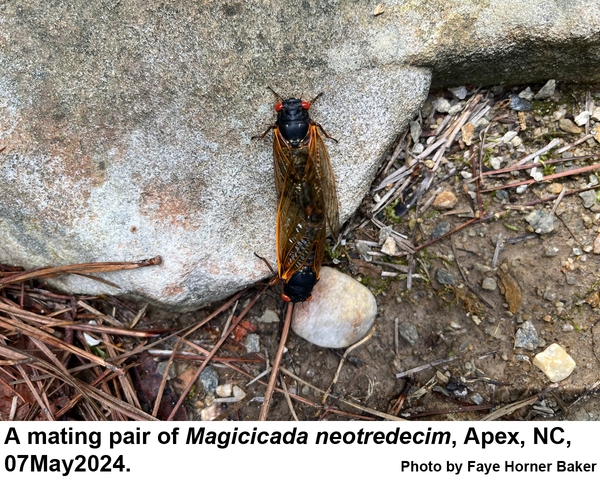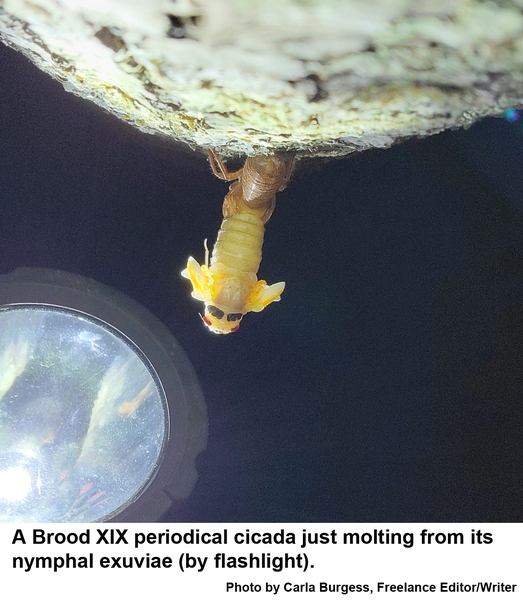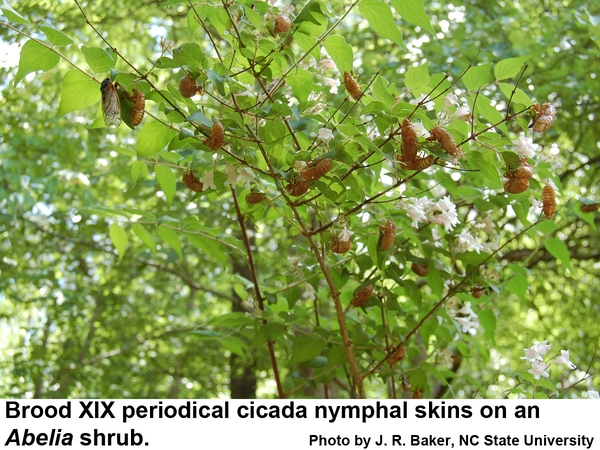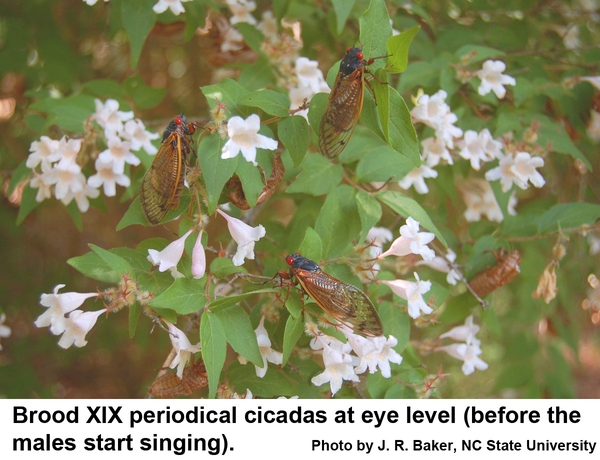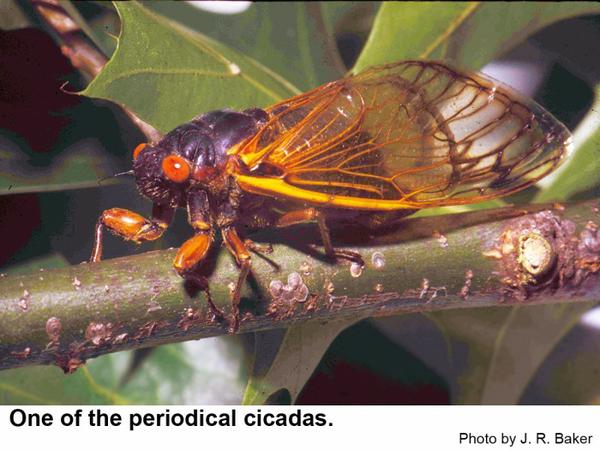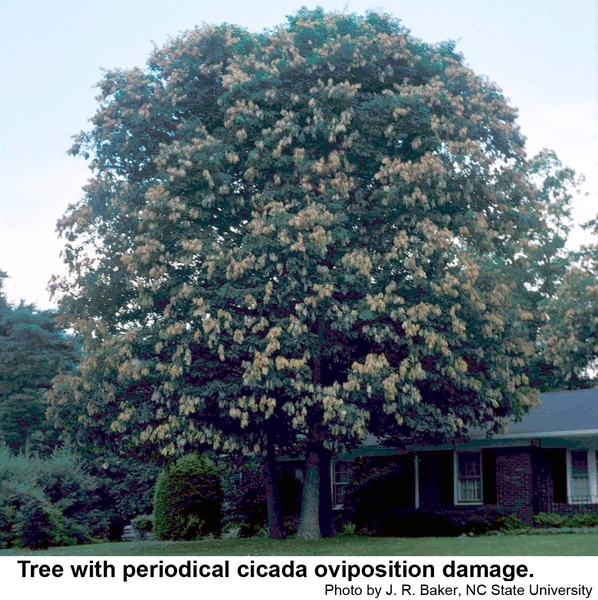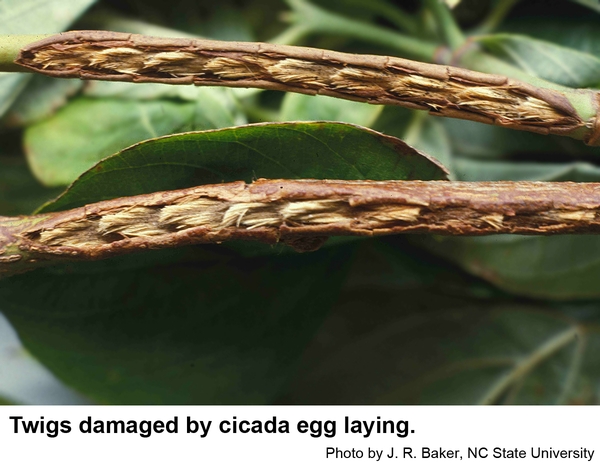Description and Biology
Periodical cicadas (Magicicada septendecim and five other species) are amazing insects. They spend most of their lives as tiny to fairly large nymphs feeding on roots of trees (usually 13 or 17 years!). In late April and May, nymphs then emerge from the soil to molt into adults that live only a few weeks. Male cicadas sing a shrill mating call to attract females. After mating, females jab their eggs into the bark or twigs in a double row up to four or five inches long. Tiny pale nymphs hatch six to ten weeks later and drop to the soil. Broods numbered I to XVII are seventeen year cicadas and broods XVIII to XXX are thirteen year cicadas. However, some periodical cicada broods have gone extinct so now there are only twelve distinct seventeen-year broods, and three distinct thirteen-year broods that emerge in various parts of the eastern United States. We have six broods that emerge in North Carolina: Brood XIX will emerge in 2024 and 2037. Brood XIV will emerge in 2025 and 2042. Brood XXII will emerge in 2027 and 2044. Brood XVIII will emerge in 2028 and 2041. Brood II will emerge again in 2030 and 2047. Brood II is the most abundant of the periodical cicadas. It emerges in the foothills of North Carolina all the way up into New England. Brood II includes Linnaeus' seventeen year cicada, Magicicada septendecim. Brood X will emerge in 2038 and 2055. Other broods emerge in areas to our west and north.
Host Plants
Cicada nymphs feeding on tree roots can reduce wood accumulation and flowering of shrubs and trees. Adults also feed on plant juices, but usually not enough to be noticeable. The only aparent damage cicadas cause happens during oviposition as females jab their eggs into small stems of numerous kinds of handwood trees. These stems eventually die and “flag' over before finally dropping to the ground weeks, months, or even years later. Sometimes trees are able to callous over the oviposition scars and the stem survives.
Residential Recommendation
Although it seems a shame to kill these amazing animals, Sevin is actually labeled for cicada management primarily in apple orchards where flagging stems lower yields. This is a "Catch 22" because in apple trees, Sevin can cause premature fruit drop.
References
- Cicada Mania. Anonymous. 2020. Dedicated to cicadas, the most amazing insects in the world.
- Cicadas. Frank, S., J. R. Baker, and S. Bambara. 2002. Entomology Insect Notes, NC State Extension Publications
- Comparison of Exclusion and Imidacloprid for Reduction of Oviposition Damage to Young Trees by Periodical Cicadas (Hemiptera: Cicadidae). Ahern, R. G., S. D. Frank, and M. J. Raupp. 2006. J. Econ Entomol. 98 (6): 2133-2136.
- Magicicada septendecim, Linnaeus' 17-year cicada. Gulker, M. 1999. Animal Diversity Web. Accessed October 10, 2013.
- The ecology, behavior, and evolution periodical cicadas. Williams, K. S. and C. Simon. 1995. Ann. Rev. Entomol. 40: 269-95.
- The 2018 Periodical Cicada Emergence. Cooley, J. R. 2018. 2018 Magicicada Brood II Records.
- Extension Plant Pathology Publications and Factsheets
- Horticultural Science Publications
- North Carolina Agricultural Chemicals Manual
For assistance with a specific problem, contact your local N.C. Cooperative Extension Center.
This Factsheet has not been peer reviewed.
Publication date: May 8, 2013
Reviewed/Revised: May 7, 2023
Recommendations for the use of agricultural chemicals are included in this publication as a convenience to the reader. The use of brand names and any mention or listing of commercial products or services in this publication does not imply endorsement by NC State University or N.C. A&T State University nor discrimination against similar products or services not mentioned. Individuals who use agricultural chemicals are responsible for ensuring that the intended use complies with current regulations and conforms to the product label. Be sure to obtain current information about usage regulations and examine a current product label before applying any chemical. For assistance, contact your local N.C. Cooperative Extension county center.
N.C. Cooperative Extension prohibits discrimination and harassment regardless of age, color, disability, family and marital status, gender identity, national origin, political beliefs, race, religion, sex (including pregnancy), sexual orientation and veteran status.

